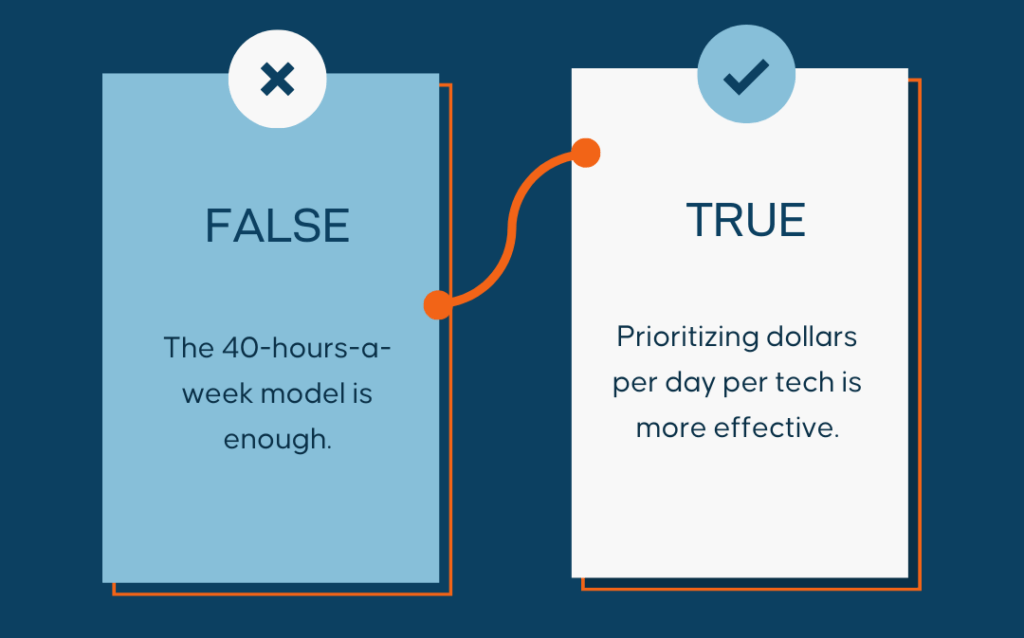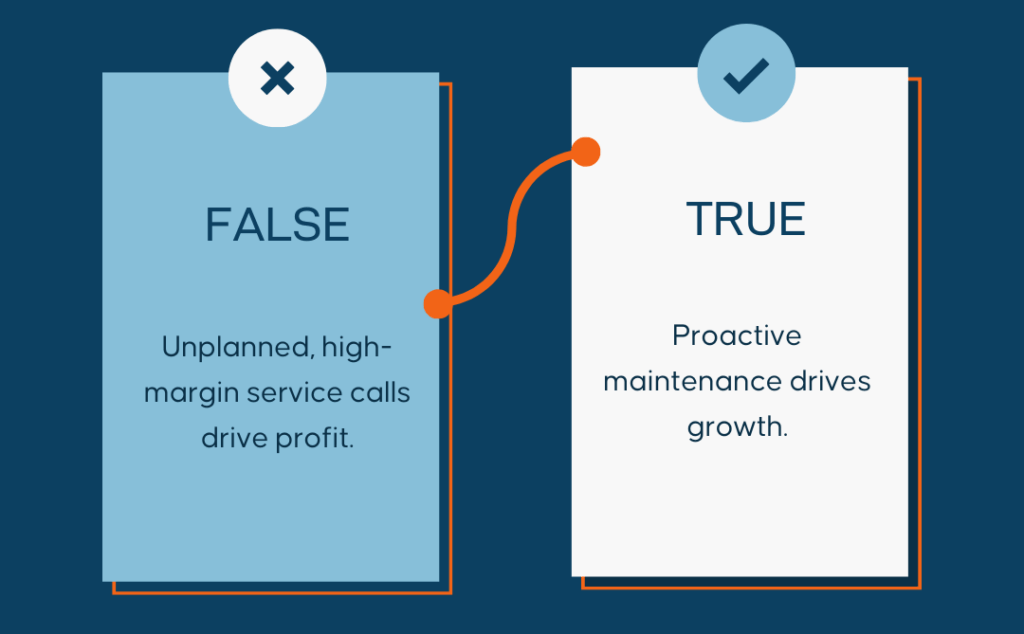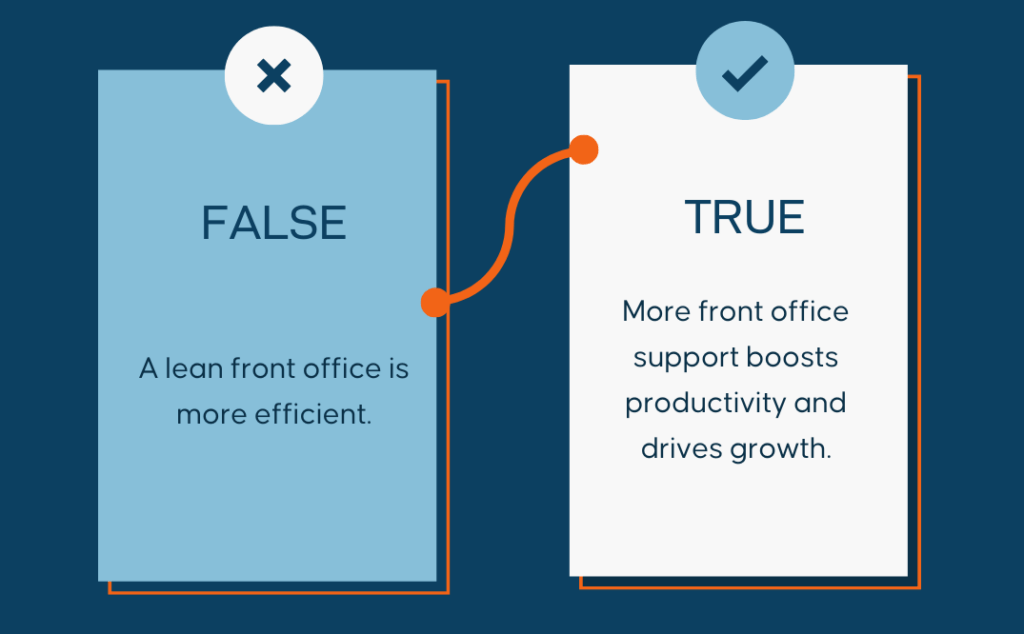Grow Revenue with Smarter Scheduling: Why Your Techs’ Schedules Are Holding You Back
In today’s fast-paced commercial service industry, efficient scheduling can be the difference between thriving and merely surviving. As a service contractor, you might think your current scheduling practices are doing the job, but the data suggests otherwise. Many commercial contractors are leaving significant money on the table because their scheduling practices, based on outdated industry “best practices,” are no longer effective.
The Hidden Costs of Outdated Technician Scheduling Practices
For decades, the standard approach to technician scheduling has revolved around three core principles: ensuring your techs are booked for 40 hours a week, responding to high-margin service calls as quickly as possible, and keeping front-office operations lean to cut costs. On the surface, these practices seem like common sense. After all, a full schedule should lead to full productivity, right?
Unfortunately, this couldn’t be further from the truth. In an industry grappling with a 40% shortage of skilled labor, these practices are not just ineffective—they’re detrimental. The data tells a different story, revealing that the most successful contractors are not the ones following these outdated rules. Instead, they are adopting innovative strategies that prioritize efficiency, profitability, and long-term growth.
Why 40 Hours a Week Isn’t Enough

One of the most pervasive myths in the service industry is that scheduling techs for a full 40-hour week is the key to maximizing productivity. However, the data shows that simply filling up those 40 hours isn’t enough. The most successful contractors go a step further by setting daily revenue goals—dollars per day per technician—that ensure every hour worked contributes maximally to the bottom line.
These contractors equip their dispatchers with the tools to prioritize high-revenue work. By providing visibility into the estimated revenue of upcoming work orders, dispatchers can make informed decisions that align with the company’s financial goals. Managers, in turn, can track progress in real-time, monitoring dollars per day per tech, and per dispatcher. This approach isn’t just about keeping techs busy; it’s about ensuring every hour they work is as profitable as possible.
As a result, commercial contractors who adopt the dollars-per-day scheduling strategy are earning 25% more revenue per tech. This significant boost in profitability demonstrates the power of strategic scheduling that goes beyond simply filling up a workweek.
The Hidden Costs of Service Calls

High-margin service calls are often seen as the lifeblood of a service contractor’s business. However, the reality is that these calls come with hidden costs that can severely impact your profitability. The chaos caused by unplanned service calls—whether it’s the scramble to respond, the extra drive time, or the resulting unhappy customers—can crush your bottom line.
Data shows that commercial contractors who minimize emergency service calls are growing 40% faster than their peers. How? By focusing on proactive inspection and preventative maintenance work, they earn more pull-through repair work. This strategy allows them to secure high-margin repair jobs before they turn into emergency situations that disrupt schedules, waste valuable time, and inconvenience your customer.
Instead of dealing with the fallout from last-minute service calls, these contractors are taking a proactive approach, addressing potential issues before they escalate. This not only improves customer satisfaction but also streamlines operations, reducing the chaos that can derail even the best-laid plans.
The Counterintuitive Secret: More Front-Office Support

One of the most counterintuitive findings in the data is the importance of front-office support. Conventional wisdom suggests that keeping the front office lean is the best way to cut costs and improve efficiency. However, the fastest-growing contractors are doing the opposite—they’re investing in more front-office support per tech.
Why does this work? With more administrative staff, dispatchers have the time and resources to make better scheduling decisions. They can reduce tech turnaways and minimize windshield time, making each tech more productive. Furthermore, by offloading tasks like data entry and paperwork from techs to office staff, contractors can keep their techs focused on what they do best—servicing customers.
The results speak for themselves. Contractors who embrace this approach are earning over 20% EBITDA because the productivity gains far outweigh the additional costs of office staff. By optimizing their support structure, these businesses are not just saving money—they’re making more of it.
It’s Time to Rethink Your Technician Scheduling Strategy
The data doesn’t lie. Contractors who continue to rely on outdated scheduling practices are leaving significant revenue on the table. In contrast, those who have embraced modern, data-driven strategies are reaping the rewards.
By setting daily revenue goals, focusing on proactive maintenance, and investing in front-office support, you can transform your scheduling system into a powerful tool for growth. Contractors who have made these changes are seeing 25% more revenue per tech, growing 40% faster than their peers, and achieving over 20% EBITDA.
It’s time to stop following outdated industry “best practices” and start making data-driven decisions that will propel your business forward. Remember, feelings fool, data rules.
BOOST PRODUCTIVITY WITH SERVICETRADE'S SCHEDULING AND DISPATCHING
ServiceTrade makes it easier for coordinators to create schedules for service technicians that improve field productivity.
ServiceTrade gives dispatchers the information they need to dispatch field technicians to service calls.
Ensure you get the right techs to the right job at the right time.
RELATED RESOURCES
BUILD BETTER TECHNICIAN SCHEDULES

In a commercial service contracting business, efficiency isn’t just a goal—it’s a necessity. You know firsthand how quickly missed appointments, overloaded schedules, and disorganized dispatching can erode customer trust and cut into profits. These problems don’t just cause headaches; they impact your bottom line and your company’s reputation. But there’s a solution. With the right […]
Tasking ensures that every maintenance activity is scheduled, tracked, and executed with precision.
